|
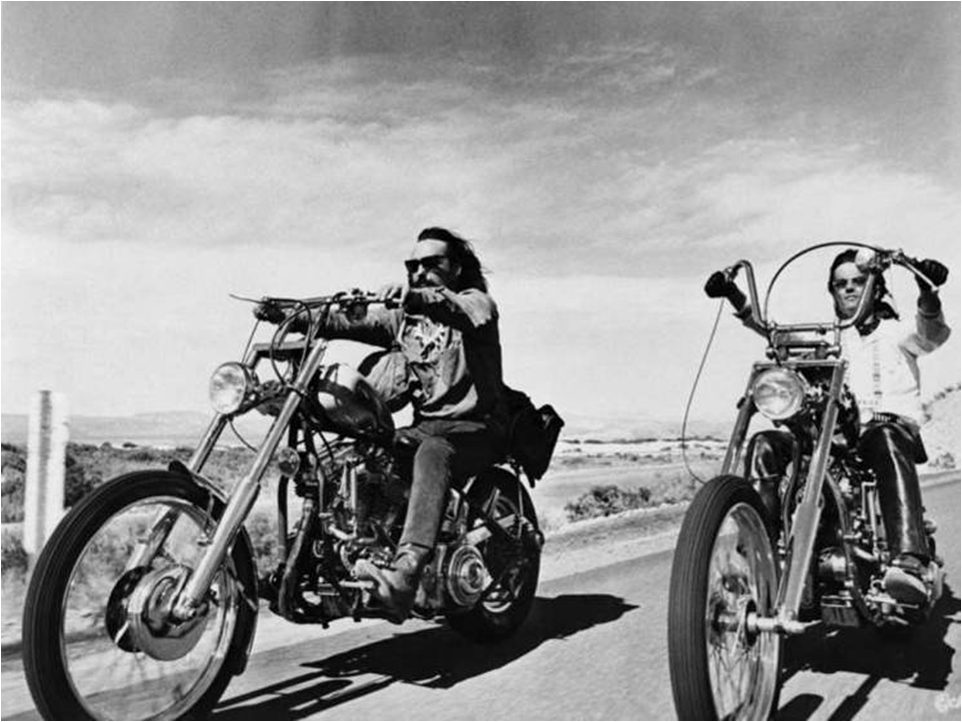
For those of you who are too
young to recognize the picture above, it's from a scene showing the two main
characters (L to R: "Billy" played by Dennis Hopper and "Wyatt" played by Peter
Fonda) from the movie Easy Rider, riding their choppers down the highway.
The picture is full of symbolism and tells us a story all on its own.
Look it over for a few minutes and just let it talk to you.
You'll
notice the two riders aren't encumbered with anything, their clothing and long
hair blowing back in the wind takes you back to the 60s. The spokes of the
wheels are blurred leaving you with no doubt that they're moving. Harder to see
is the simple baggage just bed rolls and backpacks tied on each motorcycle
suggesting this isn't just a ride down the street but a trek, an adventure. The
land in the background is wide open, no houses or buildings. There're very few
manmade objects that appear in the picture; except for the motorcycles and the
highway. The large amount of sky suggests wide open spaces and the eternal
freedom of the American cowboy a connection the American motorcycle companies
love to play on.
It's obvious that these men are on the road traveling
somewhere. For some their image represents the freedom of motorcycling; freedom
of the highway; freedom to travel wherever and whenever they like; unencumbered
basic American freedom…
In truth if you watch the movie, you'll
discover that both of these freedom loving characters are actually drug dealers
as well as users. The movie opens with them buying drugs in Mexico, and then
delivering them up north and getting paid for their ride across the border. The
movie makes this very clear. After making a bundle on the drug sale they use
their new wealth to finance a road trip to New Orleans for Mardi Gras. In the
process of riding their motorcycles across the southern part of the country
they discover "America"??
Billy and Wyatt are very typical hippie
characters of the late 60's; the movie has our heroes smoking grass in just
about every scene. Interestingly enough the actors actually did smoke marijuana
in all the scenes depicting them smoking grass. Not at all unusual for the
time..
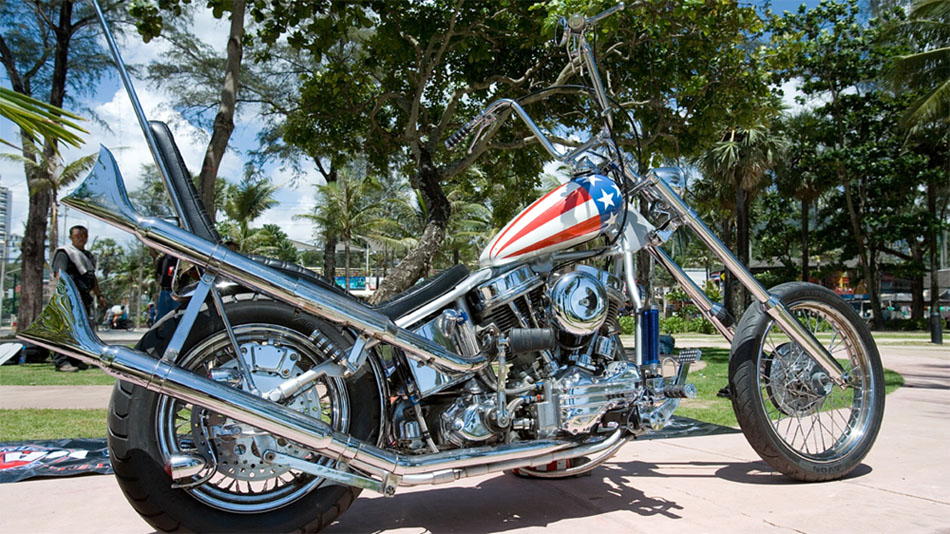 A good copy of Captain America A good copy of Captain America
The movie drags out every
stereotype you can think of. Easy Rider is considered by some to be one of
Hollywood's land mark films. It was the beginning of the "anti-hero" main
character movies to come to the screen in the late 60s and 70s. The bad guys
that you start to like as you watch the movie, and by the movie's end you're
feeling empathy for them. You've forgotten they're really bad guy drug dealers.
In spite of them being bad guys; you're shocked and horrified at the fate that
befalls the main characters at the end of the movie.
As the years
passed and I watched the movie Easy Rider again and again; my feelings about
the storyline and what it's actually about started to change. I no longer
believe it was a great epic or that it depicted real life. In fact it was
another of many movies of that time period that did more to harm the reputation
of motorcyclists and motorcycling in general. Once again we were associated
with ideas and events that were not at all typical or normal for motorcycling
anywhere.
Never mind that the movie also re-enforced stereotypical
characteristics to the different characters they encounter in each area of the
country. And like everyone else who see the movie I was shocked and horrified
by its ending. Because I was misled by the plot and the story line and my own
circumstances at the time (1969); like everyone else I felt that empathy for
the movie's anti hero-hero drug dealers. However, as time went on and I
matured, slowly my empathy for the characters changed. I began to look deeper
into them and began to feel about them the same why I did about what happened
to them at the end of the movie. Nowhere and at no time do two wrongs equal a
right.
The movie was made and débuted in the late 60s. If you
weren't living then or you were just too young at the time to remember, you may
not understand prevailing attitudes of American youth. Most of us were uneasy
about the future and felt as if everything we have come to take for granted was
about to disappear. We were facing a very uncertain future; we grew up
experiencing the terror of the cold war and its threat of total annihilation
from Soviet nuclear missiles.
Add to that the threat of being drafted
and sent to Viet Nam to fight in a war not everyone understood clearly. Even
presidents weren't safe (JFK's assassination November 22, 1963), and our cities
were under the constant threat of riots fueled by racial conflicts of the time.
We were constantly seeing young people on television demonstrating against the
government about the war and racial policies. It seemed as though America was
becoming more and more violent and changes were happeing so quickly. Our
televisions were full of images of death and destruction from Viet Nam, riots
in our cities, and from the college campuses demonstrating against things a few
years ago we would never think of questioning. We were caught up in changes, a
sexual revolution, a increase in drug experimentation and constant racial
changes; all the time still worried about being drafted and total nuclear
destruction. ..
(May 1964 during
civil rights protests in Birmingham, Ala., Commissioner of Public Safety Eugene
"Bull" Connor uses fire hoses and police dogs on black demonstrators. These
images of brutality, which are televised and published widely.
Sept. 15
(Birmingham, Ala.) Four young girls (Denise McNair, Cynthia Wesley, Carole
Robertson, and Addie Mae Collins) attending Sunday school are killed when a
bomb explodes at the Sixteenth Street Baptist Church, a popular location for
civil rights meetings. Riots erupt in Birmingham, leading to the deaths of two
more black youths.
August 26 to August 29, 1968 the Democratic National
Convention was held at the International Amphitheatre in Chicago, Illinois, the
purpose of the convention was to select a new presidential nominee to run as
the Party's candidate for the office of President of the United States. The
convention was held during a year of violence, political turbulence, and civil
unrest, particularly riots in more than 100 cities following the assassination
of Martin Luther King, Jr. on April 4 and the assassination of Democratic
presidential hopeful Senator Robert F. Kennedy of New York, who had been
murdered on June 5. The proceedings became notorious for the large number of
demonstrators and the use of force by the Chicago police. During the rioting
the Chicago Police Department was assisted by the Illinois National Guard to
restore order. The disturbances were well publicized by the mass media, with
some journalists and reporters being caught up in the violence. Network newsmen
Mike Wallace and Dan Rather were both roughed up by the Chicago police while
inside the halls of the Democratic Convention.
May 4th, 1970 Ohio
National Guard troops opened fire on students, wounding nine and killing four
at Kent State University. )
The hippie movement with
its free love and drug use demonstrated America's decision to just "give up and
enjoy the moment" kind of thinking.
Unless you were a young adult
then, you might not be able to judge this film, except on its cinematography,
acting, and script; none of which is all that good. Peter Fonda produced and
Dennis Hopper directed the film. There wasn't a real script; most of the
actor's lines in the movie are adlibs.
There are some sections of the
movie, where the cinematography conveys the freedom of the road and openness of
America is directly from the genius of Hopper's direction; other than those few
moments in the movie, it isn't really all that good.
The stereotypical
images of bad boy long haired "hippie" motorcyclists riding through different
areas of the country; and having adventures along the way was appealing and
still is. The movie is full of conflicting ideas; the idea that the western
part of the United States is large open ground, filled with open minded good
hearted people willing to lend a hand and help out strangers. Where Later on
the movie contrasts the west with the southeast; where everyone is closed
minded, fearful, mean spirited, redneck, good ole boys. They played on the
stereotypes to carry the movie and reinforce fears of the time.
(In Neshoba County in
central Mississippi, three civil rights field workers disappear after
investigating the burning of an African American church by the Ku Klux Klan.
Michael Schwerner and Andrew Goodman, both white New Yorkers, had traveled to
heavily segregated Mississippi in 1964 to help organize civil rights efforts on
behalf of the Congress of Racial Equality (CORE). The third man, James Chaney,
was a local African American man who had joined CORE in 1963. The disappearance
of the three men garnered national attention and led to a massive FBI
investigation that was code-named MIBURN, for "Mississippi
Burning.")
What prompted my search for
Captain America was an email exchange I had concerning the picture. He
explained in his email that he was told by a friend that the original Captain
America bike was located in a shop in Michigan and that the owner had paid over
a million dollars for it.
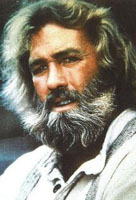
Dan
Haggerty |
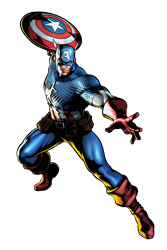 I remember reading an interview with Peter Fonda and he remarked
that the two Billy bikes and one of the Captain America choppers were stolen.
The remaining Captain America bike was crashed in the final scene of the movie. I remember reading an interview with Peter Fonda and he remarked
that the two Billy bikes and one of the Captain America choppers were stolen.
The remaining Captain America bike was crashed in the final scene of the movie.
My memory has never been all that good, even when I was young; and now
it mixes things up pretty good. But I didn't remember hearing or reading
anything about the Captain America chopper winding up in Michigan.
I
remembered something about Dan Haggerty who played "Grizzly Adams" on
television was one of the motorcycle wranglers on the film Easy Rider. He was
also a close friend of Peter Fonda. Fonda gave Haggerty the wrecked Captain
America chopper used in the final scene of the movie as a memento.
So
I went looking for the Captain America chopper. However the real Captain
America showed up. Not the motorcycle but the superhero Captain America. Low
and behold he's riding a modified Harley Davidson WLA; but, that's another
story.
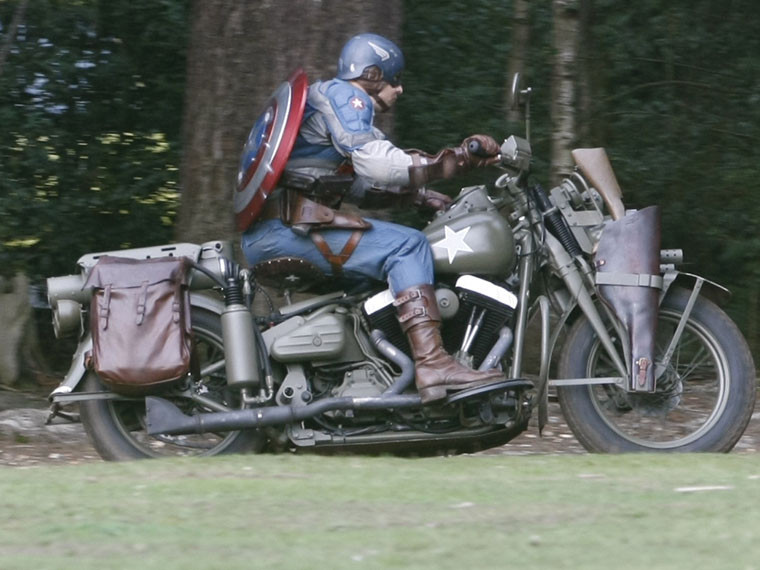
Captain America on his
Harley, protecting America
The Captain America chopper
was on display in the Guggenheim's Art of the Motorcycle show. The one in the
Guggenheim display wasn't the original; it was an exact copy made from pictures
and publicity stills from the movie. So where is the original, could it be in
Michigan?
All through this search my disappointment in Peter Fonda (who is
worshipped for his part of Wyatt or "Captain America" in the movie Easy Rider
by the cruiser motorcycle crowd) didn't keep the bike himself. You see, Peter
Fonda wasn't a biker or motorcyclist, he just used them to make movies;
motorcycling for him was a passing fancy and a way to make money.
But
where is the Captain America motorcycle? The best and most reliable information
comes from the book "Legendary Motorcycles: The Stories and Bikes Made Famous
by Elvis, Peter Fonda, Kenny Roberts, and Other Motorcycling Greats" by Basem
Wasef
"The existence of the
real Captain America motorcycle has been the subject of much speculation. It is
widely agreed that the two Billy bikes and one of the two Captain America bikes
were stolen just before the completion of filming, never to be recovered. The
fate of the Captain America motorcycle that was destroyed in the final scene of
the movie however is more convoluted. According to one source, the wreckage of
the Captain America bike was gifted to Dan Haggerty (who handled the bike
during production) as a memento from Peter Fonda. Haggerty allegedly restored
the bike in his Woodland Hills, Californina home, and after it didn't meet
reserve at one auction, John Parham purchased it at another auction. Though he
prefers not to disclose the purchase price, Parham says, "I paid a lot for it.
You can buy a nice, decent house for that price." Parham asserts that a
certificate of authenticity signed by Fonda and Haggerty validates the bike's
roots, but Texas resident Gordon Granger also owns what he believes is the real
Captain America, and he also possesses a certificate signed by Haggerty
claiming authenticity."
What about the one in
Michigan; I suspect it's not one of the stolen ones, but a copy. If it was one
of the stolen ones it would have been discovered during the search to prove its
providence (providence: documentation proving its origins and authenticity) for
the motorcycle. And no I don't believe anyone paid a million dollars for
it….
As far as the one owned by John Parham who by the way is the
genius behind J&P Cycles® the largest aftermarket motorcycle parts and
accessories cataloger and online retailer on the planet! Their world
headquarters is located in Anamosa, Iowa… Hummmm now what?
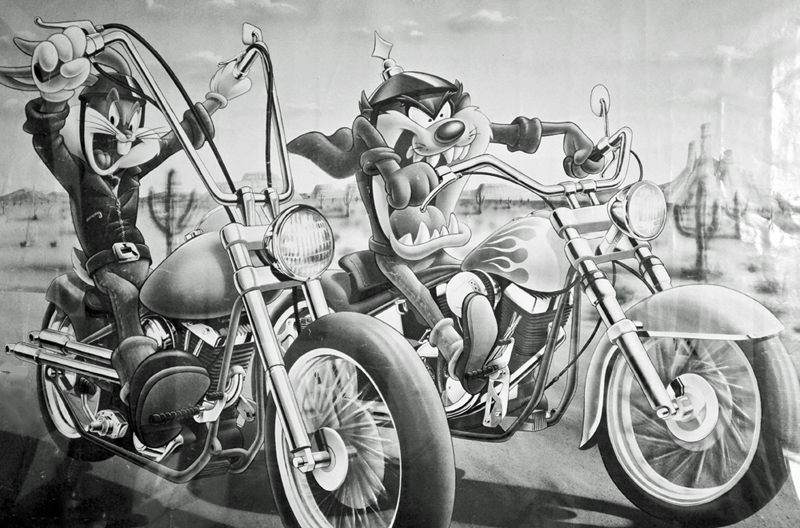
Even Buggs and
Taz got into the act....
|


 A good copy of Captain America
A good copy of Captain America
 I remember reading an interview with Peter Fonda and he remarked
that the two Billy bikes and one of the Captain America choppers were stolen.
The remaining Captain America bike was crashed in the final scene of the movie.
I remember reading an interview with Peter Fonda and he remarked
that the two Billy bikes and one of the Captain America choppers were stolen.
The remaining Captain America bike was crashed in the final scene of the movie.

